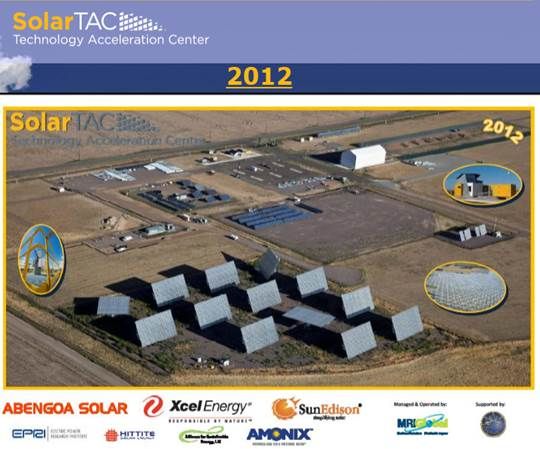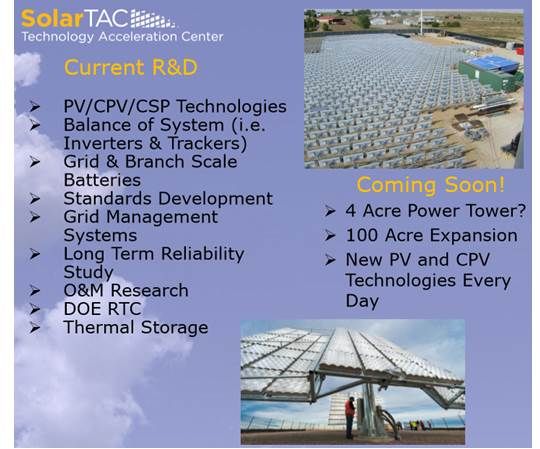The Solar Technology Acceleration Center (SolarTAC) is a member-based research facility in Aurora, Colorado focusing on proprietary solar research and development, demonstration, testing and validation of solar thermal, photovoltaic (PV) and concentrated PV systems.
Founding members Xcel Energy (NYSE:XEL), SunEdison, and Abengoa Solar collectively put up $6 million to launch the facility.
Sponsoring members are the Electric Power Research Institute (EPRI), Hittite Solar Energy, Amonix, and the Alliance for Sustainable Energy. "MRI Global, a partner in the Alliance and the operator of SolarTAC, hired me in 2008,” said Executive Director Dustin Smith, “to take SolarTAC from an idea to reality.”
Founding members’ annual fee is $500,000 for the first three years and $100,000 per year subsequently. Sponsoring members’ annual fee is $100,000. All pay infrastructure-use fees based on the amount of space they occupy at SolarTAC.
There are two newer membership classifications. Commercial sponsors can offer products to SolarTAC research projects. Incubator members can use up to 2,500 square feet of the facility for a smaller membership fee.
In response to legal and economic requirements to obtain and integrate new technologies without compromising ratepayer costs or grid reliability, Smith said, Xcel Energy “started looking for a neutral place where the industry could innovate and utilities could identify technologies they might be able to implement. That was the genesis of SolarTAC.”

While Xcel and NREL developed the concept, SunEdison and Abengoa Solar joined. “We refer to Xcel as the founding member because they started the idea and contributed the most money,” Smith said. Now, Smith added, though SolarTAC is not for profit, “we are self-sustaining. Our costs are less than our membership and fee revenues.”
For their fees, users get outdoor sites for “practical, outside-the-lab, beyond-beta, ‘how do I make it work at scale?’ testing. You get a green field, your space with your fence, and your lock. You build whatever you need to drive your project.”
The City of Aurora, Colorado leases the 74-acre site to SolarTAC at no cost. But, Smith noted, “we’ve brought the city between $50 million and $100 million in everything from permit fees to local business activity.”
At the site, “we’ve graded and put in security and gate systems. The 2007 University of Colorado solar decathlon house, which was donated by Xcel, is available as an indoor facility. All the parking and roads are in. We have water and sewage infrastructure for when the city builds out to the site. And the electrical infrastructure is there. The grid runs along our property. Everybody is grid-connected through a flexible feeder.” And NREL, Smith added, has just completed a 2,000-square-foot building, though its purpose has not yet been announced.
Work at SolarTAC can be completely proprietary, Smith said, suggesting Area 51-like secretiveness. “There is a big tent under which Abengoa is doing testing and analysis of its trough systems.”
But competitors occupy adjacent spaces and “you can be as collaborative or as proprietary as you want. Over the last couple of years, everybody got proprietary systems up. Now we’re seeing collaboration -- a company connecting to another’s battery, or one company’s system being hooked up to another’s. And we are seeing organizations speculating on further collaborations.”

Systems at the site can be connected to adjacent Xcel transmission lines “in a way that is conducive to research,” Smith explained. Through custom interconnect and power purchase agreements (PPAs), Xcel buys all power that is generated. But the agreement remains in place if the system is not generating, allowing systems to be taken apart and reconfigured without breach of the PPA. “Instead of working on a PPA or an interconnection for months or years,” Smith said, “this takes a couple of weeks.”
The City of Aurora arrangement offers a similar benefit. “Trying to permit something at utility scale with equipment that, in some cases, has never been seen before, much less covered by codes, and in most cases isn’t UL-listed or third-party-tested,” Smith said, “would be impossible.”
Smith and Aurora’s Mayor, City Manager, and City Council wrote an “Experimental Systems” law specifically for SolarTAC. “It would take five years to permit one of these systems. With this law, we got one of our largest systems permitted in six weeks. For a startup working on a new venture, getting its first test and demonstration at scale up and running four-and-a-half or five years faster saves a lot of money and accelerates the program almost overnight.”
Currently at SolarTAC, Smith said, “Xcel is working on a unique, 100-percent-programmable load feeder. It mimics residential loads and solar system feeds, with or without battery storage. They are testing how to maintain grid stability with varying loads and feeds.”
SunEdison is continuously testing panels and trackers, Smith said, and both EPRI and NREL have multiple research projects.
Hittite Solar Energy, a Turkish solar thermal provider, “has built parts of their system, direct steam generation, power production and storage, in different parts of the world and they are going to bring them together as one complete system at SolarTAC.”
Concentrating PV innovator Amonix “is doing reliability tests on thirteen 75-foot-wide, 65-foot-tall panels and applying what they learn to new projects.”
“I get to see these technologies testing side by side,” Smith said, “and see where they find their place in the world.”
***
This is the most recent in GTM's series on solar panel testing facilities. Previous entries are summarized in the GTM Guide to Solar Module Testing.



